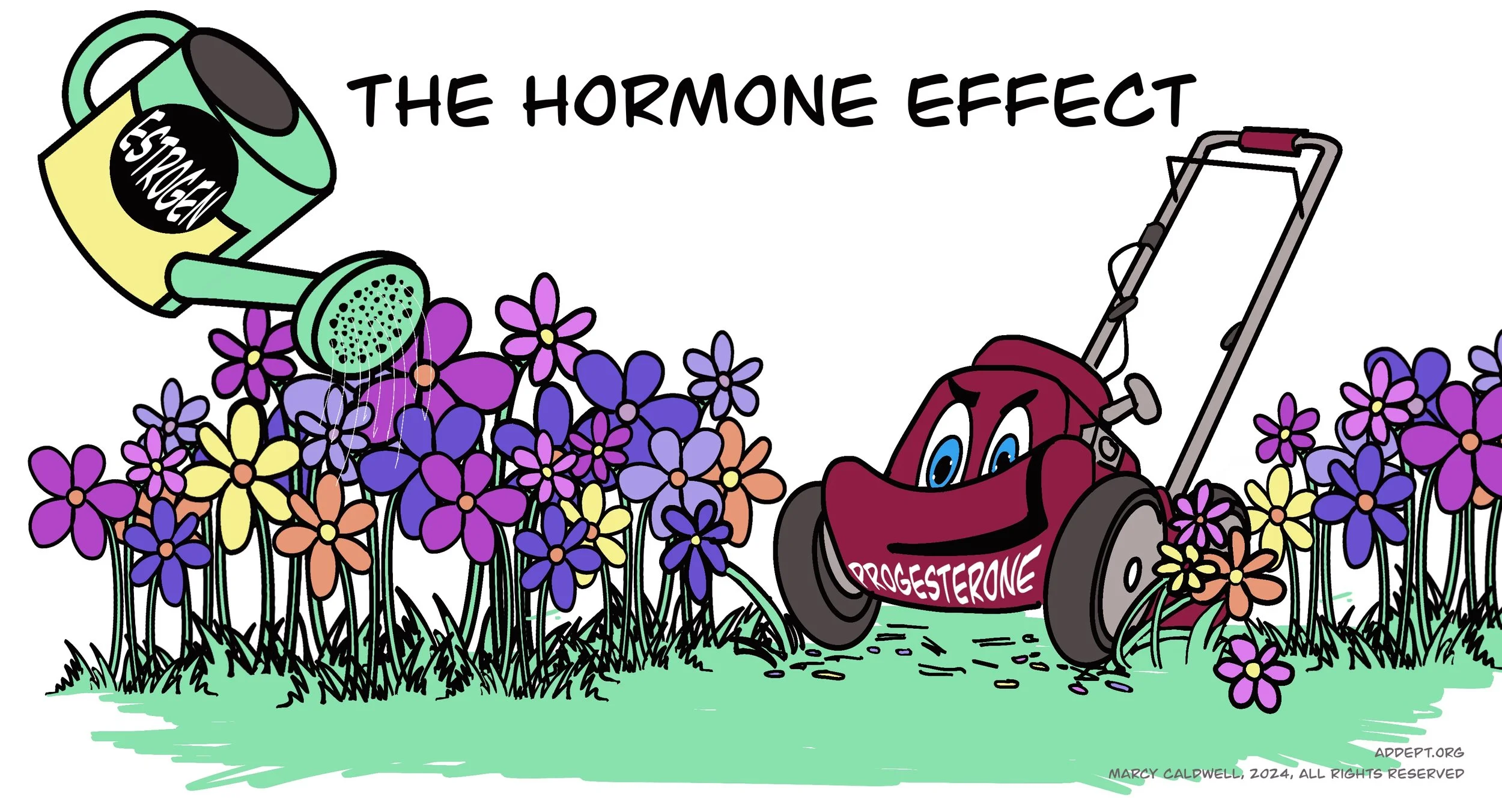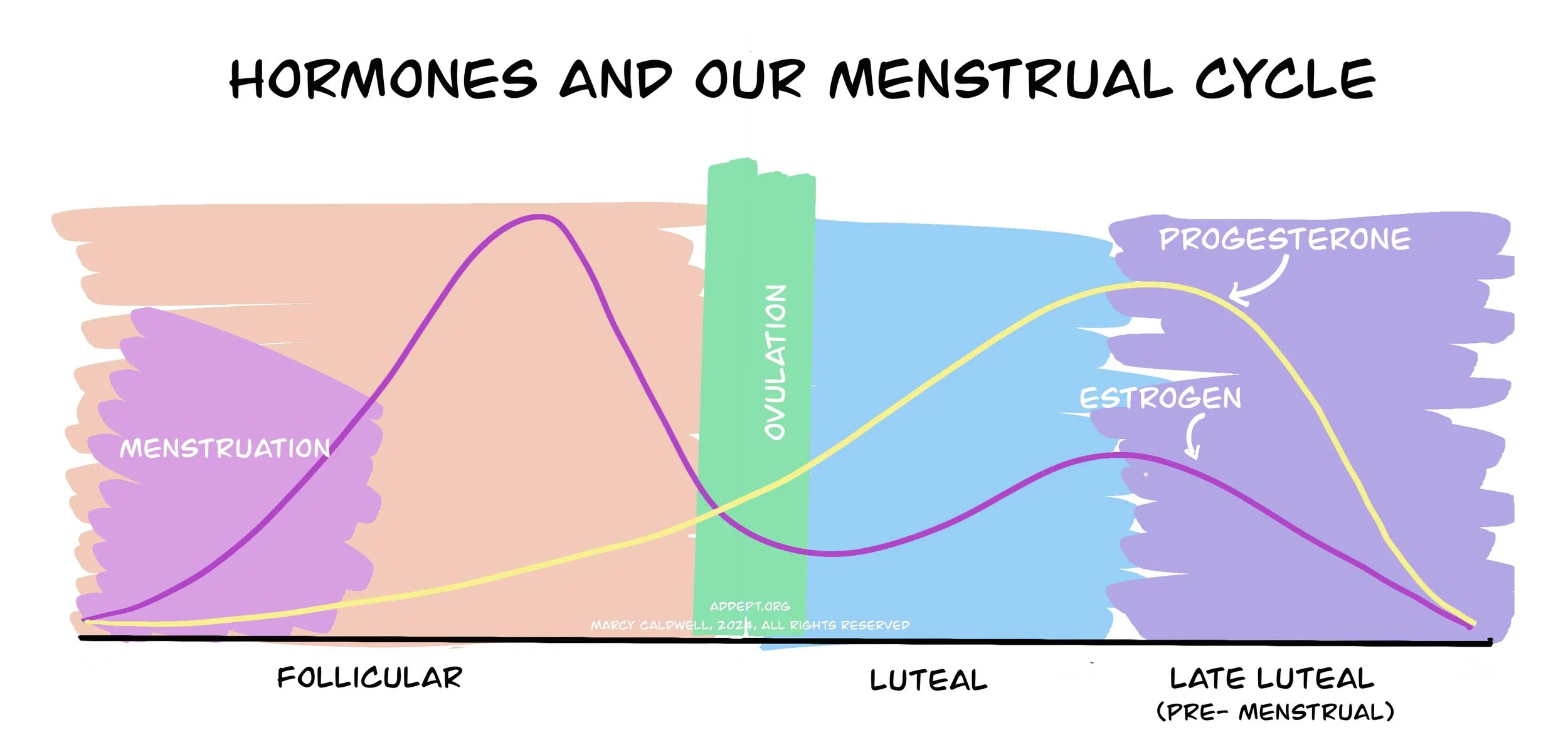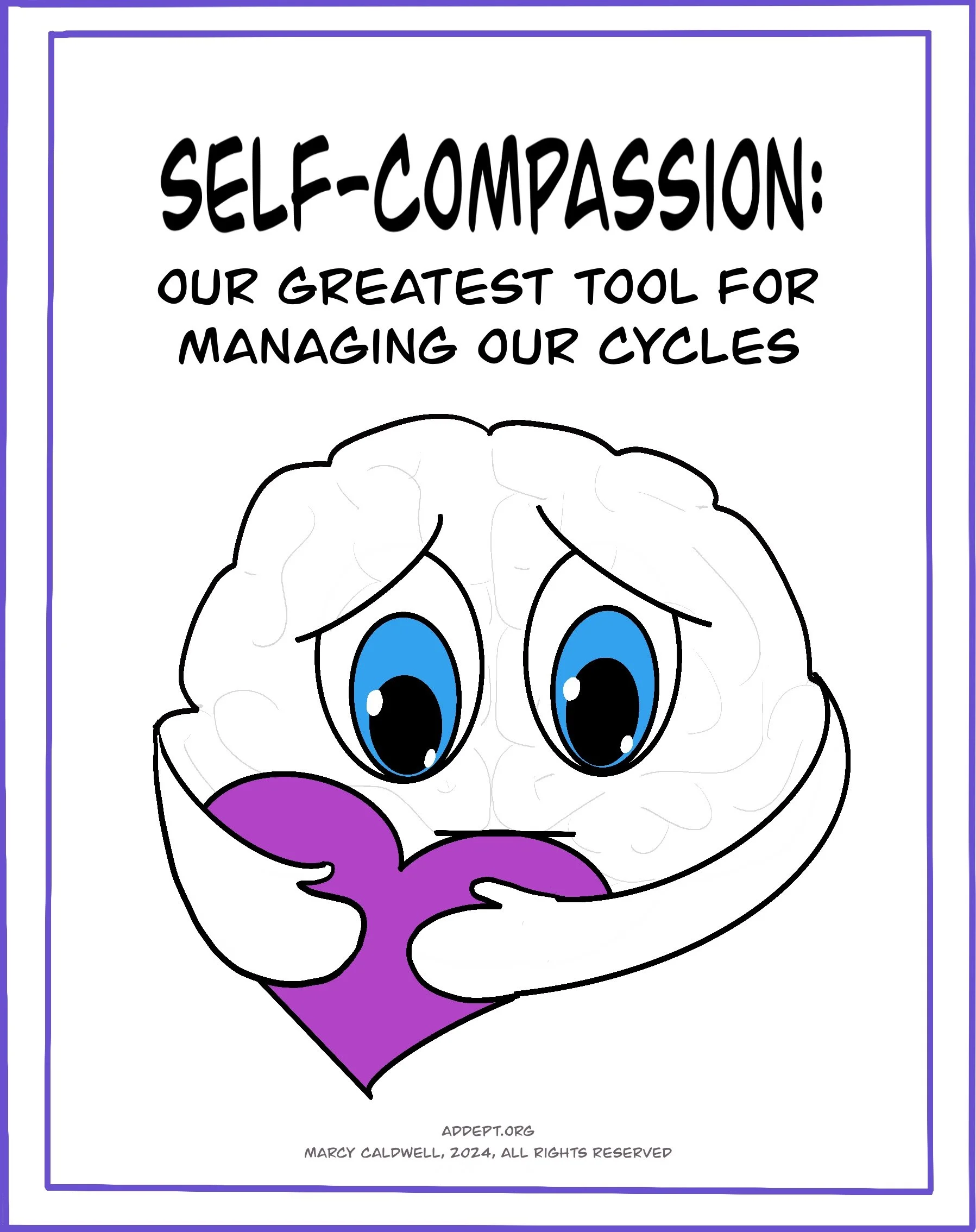ADHD & Your Period: It's Not Just in Your Head (And How to Cope)
A woman’s menstrual cycle has a significant impact on her ADHD symptoms creating constant cycling of energy and motivation levels as well as fluctuating levels of focus, emotional regualtion and mental sharpness. This constant fluctuation can make it even harder to institute systems and strategies that can help manage ADHD symptoms, making understanding our hormonal cycles and their impact on our brain and symptoms a vital step to feeling healthy, productive and well.
How the hormonal rollercoaster can affect ADHD
Ladies, do you find that your ADHD symptoms seem to hit harder at certain times of the month? If so, you’re not imagining things. Our menstrual cycle can have a profound impact on our ADHD brains. And as you’ve probably guessed, it all comes down to those pesky/ downright obnoxious hormones.
So let’s explore the role they play, plus explore how we can best manage the dastardly duo of ADHD and our menstrual cycle-– putting smart strategies into place that ensure you stay productive and focused the whole month long.
ADHD and menstruation: what’s going on in our bodies?
Think of your hormones as the directors of a movie, orchestrating various aspects of our bodies and brains’ performance (and at some times of the month, transforming that movie into a telenovela on hyperdrive!).
This is particularly true with an ADHD brain, where the hormonal fluctuations throughout the menstrual cycle ratchet that drama up to an eleven [1], leading to things like brain fog, adhd period depression, and emotional flooding—the last thing you need when all you should really be doing is climbing into fuzzy pajamas and cradling a tub of chocolate fudge ice cream.
Why does this happen? Well, it all comes down to Estrogen and progesterone and the many ways they impact dopamine.
Estrogen:
Estrogen (which is highest in the middle two weeks of our cycle) helps us create, use, and regulate the dopamine in our brains (and medication). This is great for all humans who use dopamine to keep our moods upbeat and our hearts and brains motivated. But it’s particularly useful for ADHD brains, which struggle to regulate dopamine to begin with, and for whom dopamine is at the core of almost all ADHD struggles.
Progesterone:
The impact of Progesterone is slightly more complicated. If estrogen is like a miracle-gro for our uterus and our brain’s access to dopamine, then progesterone can be thought of as a lawn mower, coming in behind it and taming back the overgrowth. Just like pruning in our yards, when given the right conditions, pruning can make everything even more lush and bountiful.
In weeks 2 and the beginning of week 3 of our cycle, when progesterone is present along with estrogen, the pruning of progesterone makes our dopamine levels bloom. However, in the absence of estrogen, progesterone seems to have several indirect effects that cause dopamine levels to plummet even further, making our ADHD feel like it goes into hyperdrive.
Managing your periods with ADHD: Cycle Syncing
So what’s the cycle of having ADHD brain to do? Well, one of our greatest tricks to navigating this period of symptom drama is called cycle-syncing.
What is cycle syncing?
Cycle syncing is a fancy way of saying- aligning your activities with your menstrual cycle.
In a nutshell, cycle syncing involves planning activities around what’s going on in our bodies at different times in our cycle so that we can harness its natural rhythms. For instance, not heading out on a week-long deep-sea kayaking trip when our energy is about to plummet.
But how does it work and what happens at different times of the month? Here’s your quick guide to cycle syncing:
The Phases and What They Mean
Follicular phase: the fresh start
Welcome to the beginning of your cycle! The follicular phase kicks off on day one of your period and lasts until ovulation.
WHAT OUR HORMONES ARE DOING
During the follicular stage, our estrogen levels start low but steadily rise over the course of two weeks, while progesterone remains relatively low.
WHAT THIS MEANS FOR OUR MOOD AND SYMPTOMS
At first, you might feel a bit low-energy and cranky—those pesky cramps and the general blahs can be tough. But hang in there because things are about to look up! As estrogen starts to rise, it’s like someone’s hit the reset button. You might notice a boost in your mood, energy, and overall zest for life. ADHD symptoms also tend to ease as this phase continues, and our brains get the estrogen/dopamine boost.
HOW TO SYNC THIS PHASE
At the beginning of this phase, while you are still menstruating, this is going to be a time to focus on self care- eating well, getting plenty of sleep and giving yourself more rest.
However, as menstruation ceases and your hormone levels rise, the tide begins to shift. This is the perfect time to tackle new projects, socialize, and embrace that wave of motivation. Think of it as your body's natural pep talk, setting you up for a great start. As you enter the second week, this is a great time to do the hard stuff- to keep at a task that has lost some of its shine, to push through some resistance, and to push your limits to see what’s possible.
Ovulation: peak performance
Ovulation is like the grand finale of the follicular phase. Around mid-cycle—usually between days 13 and 15 in a 28-day cycle—our bodies release an egg and are open to fertilization.
WHAT OUR HORMONES ARE DOING
At ovulation, our bodies are brimming with peak levels of estrogen, progesterone is at a mid-level, and we even see a dash of testosterone.
WHAT THIS MEANS FOR OUR MOOD AND SYMPTOMS
This hormonal cocktail can make us feel on top of the world. Confidence? Check. High energy? Double-check.
You might find yourself more sociable, flirty, and ready to take on whatever life throws your way. ADHD symptoms are likely at an all-time low, and you are probably more able to focus, remain resilient through struggle and frustration, and manage rejection or setbacks during this time.
HOW TO SYNC THIS PHASE
It's a great time for creative endeavors, long-range planning, high-executive functioning tasks, and connecting with others because your energy and cognitive abilities are at their sharpest. Enjoy this high-energy phase—it's your time to shine!
Luteal Phase: the wind-down
After the ovulation high, you move into the luteal phase, which lasts about 14 days until your next period starts.
WHAT OUR HORMONES ARE DOING
At first, progesterone takes the lead, bringing a sense of calm and relaxation (think of it like your body is giving you a gentle hug). But as we get closer to the end of this phase, things can get a bit tricky [2].
WHAT THIS MEANS FOR OUR MOOD AND SYMPTOMS
In the beginning part of this phase, you may experience an easing of anxiety and a greater sense of calm. But as the phase continues and estrogen and progesterone levels drop, you might experience mood swings, irritability, and of course that dreaded PMS. It’s totally normal to feel more emotional and less motivated.
The thing that doubles down the trickiness of PMS, however, is that ADHD symptoms seem to go into hyperdrive in the luteal (particularly late luteal) phase as estrogen levels and progesterone levels plummet causing dopamine regulation to plummet as well.
HOW TO SYNC THIS PHASE
Be kind to yourself during this time—self-care is key. Whether indulging in your favorite comfort food, taking a relaxing lavender bath, or just giving yourself permission to chill, do what you need to keep those spirits up.
What you don’t want to do during the final part of this stage is tackle a big, overwhelming project, make life-changing decisions, or try to solve complex problems. This is a mini-hibernation stage, and you want to give yourself the time and space to recharge.
Menstruation: the big red reset button
Now, let’s circle back to menstruation, the start of a new cycle. This phase is all about letting go—literally and figuratively. While the first few days can bring cramps and fatigue, it’s also a time for renewal. Use this time to rest and recharge. Your body is doing some heavy lifting, so give it some love with extra rest and relaxation. Before you know it, those rising estrogen levels will be gearing you up for another fresh start.
Mapping your Sync
The reason cycle syncing can be so useful is that it serves as a blueprint for what you can expect from yourself, your brain and your body which then allows you to set boundaries, realistic deadlines and appropriate expectations. It’s kind of magic actually- it allows us to tell our future!
But that future-telling magic is only possible once we really get to know our bodies. Becuase everything I said up there ☝️is just an average. And we all know you’re not just average!
This is where mapping our cycles comes in super handy. When we start tracking things like when our cycle starts and ends, along with our mood, motivation, and focus levels throughout the month, we start to get a picture of what we can expect on any given day.
And the cool thing is that it’s never been easier to do just that—gone are the days of keeping a notepad by your toilet. We now have sophisticated biometric analysis strapped to our wrists, hanging around our fingers, and tucked up in our pockets every day! So go ahead and use whichever tracking system seems best for you, and before you know it, you’ll have insights you never knew possible!
Managing your periods with ADHD: understanding medication and your menstrual cycle
Managing ADHD with medication is already a balancing act (particularly these days with shortages on the rise). And to add insult to injury, our menstrual cycle can throw another variable into the mix because just like estrogen drops cause a drop in our brain’s natural levels of dopamine, there is research that suggests that when our body’s estrogen levels drop it also causes our brains to be less able to use the dopamine our medicine gives us too!
However, research suggests that increasing your stimulant dosage during the premenstrual phase can help combat worsening ADHD and mood symptoms [3].
But please remember-- I’m not giving medical advice here (my lovely lawyers- take a deep breath)—always consult your doctor before making any changes to your medication.
Managing your periods with ADHD: be aware of birth control
Birth control can be a double-edged sword when it comes to managing ADHD symptoms. For some women, the pill can help to stabilize mood swings and improve focus. For others, they might worsen symptoms [4]. And, of course, there are so many different types- some with estrogen, some without. So, it's essential to track your symptoms and discuss them with your doctor to find what works best for you.
A Special Note about IUDs
One type of birth control, in particular, deserves extra mention: IUDs.
Many IUDs cause us not to get our period at all after a little while. And while this can be lovely for many reasons, just because your body is not bleeding doesn't mean that it’s not still cycling. So, all the same fluctuations will still occur but without the physical indicator of menstruation to help you mark the time.
This is why it can be extra important for those of us with IUDs to track our symptoms so we know where we stand!
Managing Periods with ADHD: The Essential Tool of Self-Compassion
Being the proud (and sometimes very much not so proud) owner of both an ADHD brain and a menstrual-cycling body is tough. It's really darn tough. And trying to force, bully, or beat ourselves into productivity at all times and at all costs makes it oh so much harder.
This is why self-compassion is an essential tool (and, honestly, a secret weapon). It not only saves us from the torment of the constant drive for hustle and product but also gives us the benefit of rest and recovery.
But self-compassion is a whole lot easier said than done, right?!? Here are some steps to work on to be kinder to yourself while the hormonal orchestra is playing its symphony:
Acknowledge your struggles: Recognize that your symptoms might vary throughout your cycle and that it’s okay to have tougher days.
Adjust your expectations: Give yourself permission to scale back when needed. It’s not about doing less but doing what’s best for you—knowing that there will be other days when more is not just possible but probable.
Celebrate small wins: Every achievement, no matter how small, is worth celebrating. Keep a journal to track your successes and remind yourself of your strengths.
Embrace your cycle, empower your life.
Understanding how your menstrual cycle affects your ADHD symptoms is a game-changer. By syncing your activities to monthly hormonal fluctuations, adjusting your medication (if needed), being aware of the effect that the pill can have on you, and practicing self-compassion, you can turn hormonal fluctuations into a superpower rather than a setback.
With the right strategies and support, you can stay on top of your ADHD, no matter what time of the month it is.
Extra support for the Emotional Challenges of ADHD and our Cycle
Syncing is great for knowing what to expect and helping to build our life to work with how our brains and bodies work best naturally.
But those emotions that come along with our cycling ADHD brain?!? Woah- those are a doozy!
If you are struggling to feel like you can trust yourself to follow through on your goals and intentions because of the giant emotions that threaten to bowl you over at any given moment- it might be time for some additional support.
Our powerful online ADHD course will equip you with the strategies to manage overwhelm, move on from meltdowns, and achieve emotional mastery—at any age. This program is fully research-backed and designed by psychologist Marcy Caldwell to utilize the most cutting-edge information and strategies for you and your brain. Why not start the journey to a more confident and focused you today?
-
Ronit Haimov-Kochman, & Berger, I. (2014). Cognitive functions of regularly cycling women may differ throughout the month, depending on sex hormone status; a possible explanation to conflicting results of studies of ADHD in females. Frontiers in Human Neuroscience, 8. https://doi.org/10.3389/fnhum.2014.00191
M. de Jong, D. S. M. R. Wynchank, E. van Andel, Beekman, F., & J. J. S. Kooij. (2023). Female-specific pharmacotherapy in ADHD: premenstrual adjustment of psychostimulant dosage. Frontiers in Psychiatry, 14. https://doi.org/10.3389/fpsyt.2023.1306194
Young, S., Adamo, N., Bryndís Björk Ásgeirsdóttir, Branney, P., Beckett, M., Colley, W., … Tierney, K. (2020). Females with ADHD: An expert consensus statement taking a lifespan approach providing guidance for the identification and treatment of attention-deficit/ hyperactivity disorder in girls and women. BMC Psychiatry, 20(1). https://doi.org/10.1186/s12888-020-02707-9
M. de Jong, D. S. M. R. Wynchank, E. van Andel, Beekman, F., & J. J. S. Kooij. (2023). Female-specific pharmacotherapy in ADHD: premenstrual adjustment of psychostimulant dosage. Frontiers in Psychiatry, 14. https://doi.org/10.3389/fpsyt.2023.1306194
Ready to shift from
meltdown to mastery?
This online course has been designed specifically to help teach the strategies ADHD brains need to help them move from overwhelm and meltdowns to confident emotional mastery.
Want to know more about
thriving with ADHD?
Check out these other articles:











Hormones & ADHD: the missing key